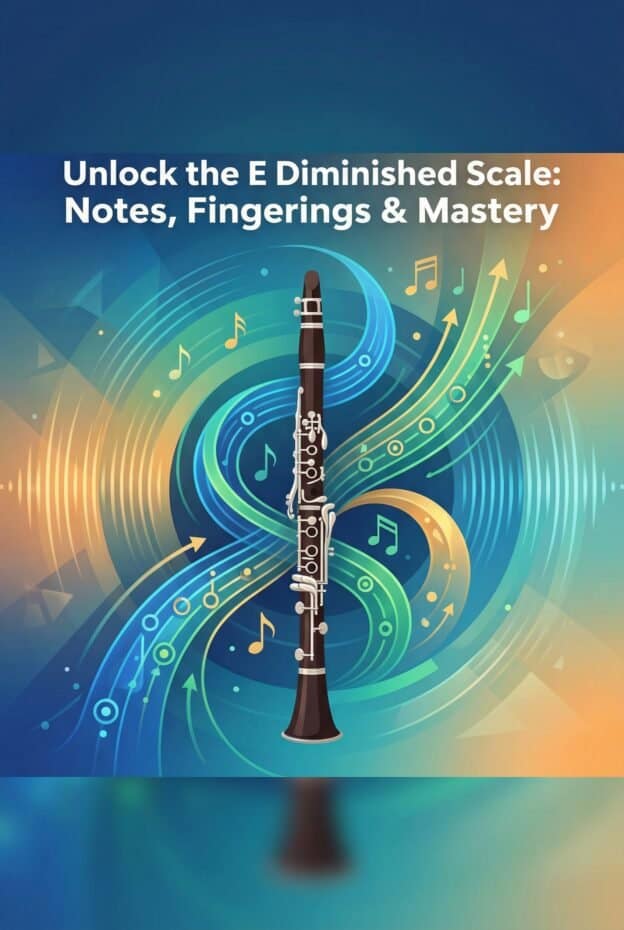The E half-whole diminished scale is a fascinating and valuable scale that every clarinetist should know. This unique scale has a rich history in contemporary music, where its distinct sound and tonal possibilities bridge different genres and styles. Emerging in the late 19th and early 20th centuries, it built on earlier musical structures, paving the way for modern compositions. Let's explore its evolution, characteristics, and historical importance in clarinet music.

Clarinet Fingering Charts are always FREE at MartinFreres.net!
The Composition of the E Half-Whole Diminished Scale
The half-whole diminished scale features alternating half and whole steps. For E, the notes are:
| Note | Step |
|---|---|
| E | Start |
| F# | Half step |
| G | Whole step |
| A | Half step |
| A# | Whole step |
| B | Half step |
| C# | Whole step |
| D | Half step |
This scale works wonderfully for both jazz improvisation and classical compositions. Its sound is both ambiguous and intriguing, allowing musicians to explore various emotions. On the clarinet, this scale can create feelings of tension and resolution, enhancing the listener's experience.
Historical Use in Jazz and Classical Music
Musicians, especially clarinetists, have long used this scale to convey complex emotions in their performances. Its role in modern jazz is particularly notable. Famous musicians like Benny Goodman and Jimmy Giuffre used the E half-whole diminished scale to add depth to their improvisations. The scale helped create melodic lines that often pushed the boundaries of traditional jazz, showcasing the clarinet's versatility. As a result, it has become essential for both new and experienced clarinetists, influencing their playing styles.
In classical music, the E half-whole diminished scale has also made its mark. Composers such as Igor Stravinsky and Arnold Schoenberg expanded traditional tonal systems, and clarinetists often use this scale to play their complex melodies. The unique features of this scale gave composers a fresh way to build tension, resulting in innovative and exciting works.
Role in Clarinet Pedagogy
Today, this scale plays a crucial part in teaching clarinet. Many instructors use it to help students develop technical skills and understand harmony better. By practicing the E half-whole diminished scale, clarinetists can:
- Improve finger coordination
- Enhance embouchure control
- Master articulation in fast passages
- Boost overall playing skill
Martin Freres Clarinets and the E Half-Whole Diminished Scale
Martin Freres clarinets are known for their precision and excellent sound quality, making them ideal for performing the E half-whole diminished scale. Players can enjoy the warm, rich tones of these instruments, allowing for expressive performances that capture the scale's evocative nature. The quality craftsmanship of Martin Freres clarinets ensures that musicians can fully express the emotional depth of this diminished scale.
Applying the Scale in Practice
If you're wondering how to use the E half-whole diminished scale in real situations, here are some steps:
- Learn the notes and fingerings on your clarinet
- Practice different articulations (slurring, staccato, accents)
- Incorporate it into your improvisations
- Use it in jazz ensembles or contemporary classical pieces
By confidently using this scale, you'll expand your musical abilities and create more interesting performances.
Conclusion
The E half-whole diminished scale has significantly impacted clarinet music throughout history. Its ability to work in various musical styles highlights its importance in both past and present clarinet performances. By mastering this scale, players gain a deeper understanding of music theory and find new ways to express themselves creatively. Next time you practice, spend some time exploring the E half-whole diminished scale – you might be surprised by the musical possibilities it opens up!







